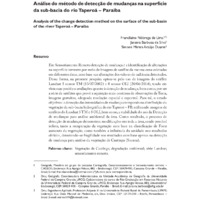Análise do método de detecção de mudanças na superfície da sub-bacia do rio Taperoá – Paraíba Analysis of the change detection method on the surface of the sub-basin of the river Taperoá – Paraíba
Item
-
Título
-
Análise do método de detecção de mudanças na superfície da sub-bacia do rio Taperoá – Paraíba Analysis of the change detection method on the surface of the sub-basin of the river Taperoá – Paraíba
-
AMBIÊNCIA
-
UFCG
-
UFRPE
-
Autor
-
Francilaine Nóbrega de Lima
-
Janaina Barbosa da Silva
-
Simone Mirtes Araújo Duarte
-
Assunto
-
Vegetação de Caatinga
-
degradação ambiental
-
sensoriamento remoto.
-
série Landsat
-
Abstract
-
Em Sensoriamento Remoto detecção de mudança é a identificação de alterações na superfície terrestre por meio de imagens de satélite da mesma cena coletadas em diferentes datas, com base nas alterações dos valores de radiância detectados. Dessa forma, na presente pesquisa optou-se pelo uso de imagens do satélite Landsat 5 sensor TM (13/07/2002) e 8 sensor OLI (20/06/2014), tendo em vista suas positivas avaliações quanto à detecção de mudança, bem como, por ser a série de satélites que provê a aquisição mais contínua de observações da Terra, imagens gratuitas, adequada resolução espacial e espectral. Para tal, o estudo objetivou a detecção das intensidades de mudanças temporais na distribuição da vegetação da sub-bacia hidrográfica do rio Taperoá – PB, utilizando imagens de satélites do Landsat 5 TM e 8 OLI, bem como, a viabilidade do uso da Detecção de mudanças para análise ambiental da área. Como resultado, o processo de detecção de mudanças demonstrou modificações em toda a área, sendo possível inferir tanto a recuperação da vegetação com base na classificação de Forte aumento da vegetação, como também a influência da umidade nos resultados obtidos, detectando-se fragilidade nos resultados com base apenas na detecção de mudança para análise da vegetação de Caatinga (Savana).Abstract In Remote Sensing change detection is the identification of changes on earth’s surface through satellite images of the same scene collected at different dates, based on changes of the detected radiance values. Thus, in this study we opted for the use of images using Landsat 5 TM sensor (13/07/2002) and 8 OLI sensor (06/20/2014), considering its positive assessments regarding the change detection as well as being the series of satellites that provides the most continuous acquisition of Earth observations, free images, adequate spatial and spectral resolution. For this, the study aimed to detect the intensities of temporal changes in the distribution of vegetation in the watershed of the Taperoá river - PB, using satellite images from Landsat 5 TM and 8 OLI, as well as the feasibility of using the detection of changes to environmental analysis of the area. As a result, the change detection process showed changes throughout the area, it is possible to infer both the recovery of the vegetation based classification of strong increase of vegetation, as well as the influence of humidity in the results, detecting weakness in results based only on the change detection for analysis of Caatinga vegetation (Savannah).
-
volume
-
13
-
issue
-
1
-
Páginas
-
183-200
-
Date
-
2017
-
Língua
-
pt
-
issn
-
2175-9405
-
Rights
-
Direitos autorais 2017 AMBIÊNCIA
 Full Text PDF
Full Text PDF